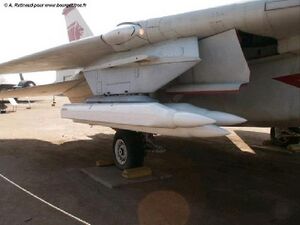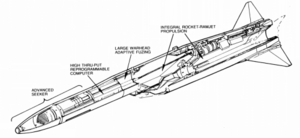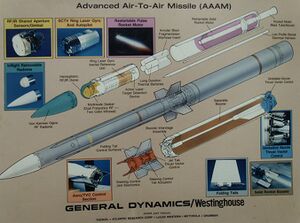Joint Advanced Anti-Aircraft Missile
| Joint Advanced Anti-Aircraft Missile | |
|---|---|
 Triple JA3M missile mount | |
| Type | Anti-aircraft missile |
| Place of origin | |
| Service history | |
| In service | 1995 - current |
| Production history | |
| Manufacturer | FFRS-Vaccari |
| Specifications | |
| Weight | 172 kg |
| Length | 3.66 meters |
| Diameter | 140 mm |
| Warhead | 16 kg blast-fragmentation |
| Engine | solid fuel multi-pulse rocket |
Operational range | 180 km maximum |
| Flight ceiling | 30,000+ meters |
| Speed | Mach 4.0 maximum |
Guidance system | INS with SARH mid-course correction, imaging infrared terminal guidance |
Launch platform | Aircraft |
The Joint Advanced Anti-Aircraft Missile (JA3M or JAAAM) is a joint Trinovantan-Lumenic long range multiple guidance air to air missile manufactured by FFRS in Trinovantum and Vaccari in Luminerra. It is intended to supplement mid-range active radar homing missiles such as the Trinovantan GLkLø-30E3 or the Lumenic AIM-15, with the JA3M having more than double the range of these systems.
Development
The development of the JA3M began in 1986 when the Lumenic company Vaccari approached FFRS to assist with the development of a long range air to air missile. FFRS, having already received a similar project requirement from the Trinovantan Air Force in 1984, agreed to merge the projects for shared development costs.
The FFRS project, essentially an enlarged ramjet powered version of their GLkLø-30 missile, was projected to be able to meet the range (at least 150 km) and speed (no slower than Mach 3.0) requirements given to Vaccari. However, its size and weight were considered too great. Additionally, Luminerra wanted a weapon that could conform to the emerging Omandan Allies weapons standardization specification. These requirements forced the FFRS proposal to be abandoned and work began largely from scratch.
In order to simplify the missile and reduce its weight, the ramjet propulsion was abandoned in favor of a solid fuel rocket. In order to reduce weight further, proposals were to primarily use thrust vectoring to maneuver. The active radar seeker of the older FFRS proposal was eliminated in favor of a combined semi-active radar and imaging infrared seeker, as these technologies had already been applied to mature weapons systems in the JA3M’s weight class.
However, the application of these various technologies into a complete package proved more daunting than expected. The JA3M suffered from cost-overruns and project delays, missing its intended service date of 1990, by which point practical prototypes of the missile were just being built for testing. Revisions made to the missile during this period caused its testing period to stretch for years longer. Low rate initial production began in 1994, but the Lumenic Legion only approved the missile for service in 1995, after the conclusion of the Omandan Continental War. The Trinovantan Air Force would follow later in the same year, with the Trinovantan Navy adopting it in 1996.
Design
The JA3M is a multiple guidance air to air missile. In a departure from most missiles of its type, the JA3M is launched from within a protective aerodynamic tube, similar to that of FFRS’s short range GLkLø-32 missile. The tube would protect the missile from aerodynamic strain when used in multiple sorties. Additionally, since the missile’s motor would ignite from within the tube, it could be fired regardless of aircraft orientation.
Propulsion is provided by a two stage solid fueled rocket motor. The initial boost stage separates the missile from the launch aircraft and pushes it up to cruise speed. Upon burnout of the boost motor, the first stage is discarded and the missile cruises towards the target. For the cruise and terminal phase, the second stage multi-pulse rocket is used. Within the cruise phase, the multi-pulse rocket is only used to make course corrections or to maintain speed. Upon reaching the terminal phase, the rocket uses its remaining fuel to aggressively intercept its target. Both rocket stages are equipped with thrust vectoring, which is the missile's primary method of maneuvering.
The missile uses Semi-Active Radar Homing throughout most of its flight, initially at launch to orient onto the target and plot an intercept. In the terminal phase, the missile uses INS guidance to maintain course with periodic mid-course updates provided via SARH. Upon reaching terminal phase, the missile’s forward radome is ejected to reveal its terminal imaging infrared seeker, a choice made for its high resistance to countermeasures. Within the terminal phase, the missile possesses maneuverability more akin to lightweight short-range air to air missiles, as it has shed much of its weight and uses aggressive thrust vectoring.
The missile’s tube can be mounted to any allied-standardized pylon either individually or in a pod of three. It can additionally be mounted to the semi-conformal fuselage hardpoints of the Trinovantan FAv-30 fighter aircraft. A special under-fuselage sled was developed for the Lumenic C.87 fighter which carries six missiles across two of the fuselage hardpoints. In 2008, the Mk 2 variant was developed to allow deployment from the internal weapons bay of the C.11 Fighter. The Mk 2 does not feature the protective launch tube of the previous variant, and its deployment profile does not require pre-ignition before weapon release.
Missile was intended for use with in-development X-band AESA RADARs with extensive track-while-scan functionality. In order to provide backwards compatibility with older aircraft, a Ku-band phased array RADAR illumination pod was developed. This pod is 3.6 meters in length, 420 mm in width, and weighs 350 kg. It has forward and rear apertures, so it can maintain illumination on a target in a wide arc both in front of and behind the aircraft, allowing for the launching aircraft to disengage after firing without losing track. Tracking pod can provide illumination for up to two missiles per pod simultaneously, though it can “queue” tracks for multiple missiles in the air that are launched in staggered pairs.
Variants
Mk 1 - Production Variant
Mk 2 - Tubeless variant for Lumenic C.11
Service History
The JA3M was first used in the 1997 Sable Conflict, deployed from both the Altomare C.87 Ciclone utilizing the C/ART-95 radar illumination pod, as well as the newer Scorza C.96 Squalo multirole combat aircraft accepted into service in 1996. AIM-95 missiles deployed from both aircraft performed exceptionally well, allowing the Lumenic Air Force to score kills against Notreceauen combat aircraft providing support to ground forces or conducting strike mission of their own while remaining outside of the engagement envelope of Notreceauen combat air patrols. Aircraft such as the as the Prévoyance Eppe IV strategic bomber and Prévoyance Epee 2000D were engaged and destroyed at ranges of 90-120 km, far outside the range of current Notreceauen medium-range air-to-air missiles
Operators
 Trinovantum as GLkLø-44 with LkRdRe-76 weapons pod
Trinovantum as GLkLø-44 with LkRdRe-76 weapons pod Luminerra as AIM-95 with C/ART-95 weapons pod
Luminerra as AIM-95 with C/ART-95 weapons pod

